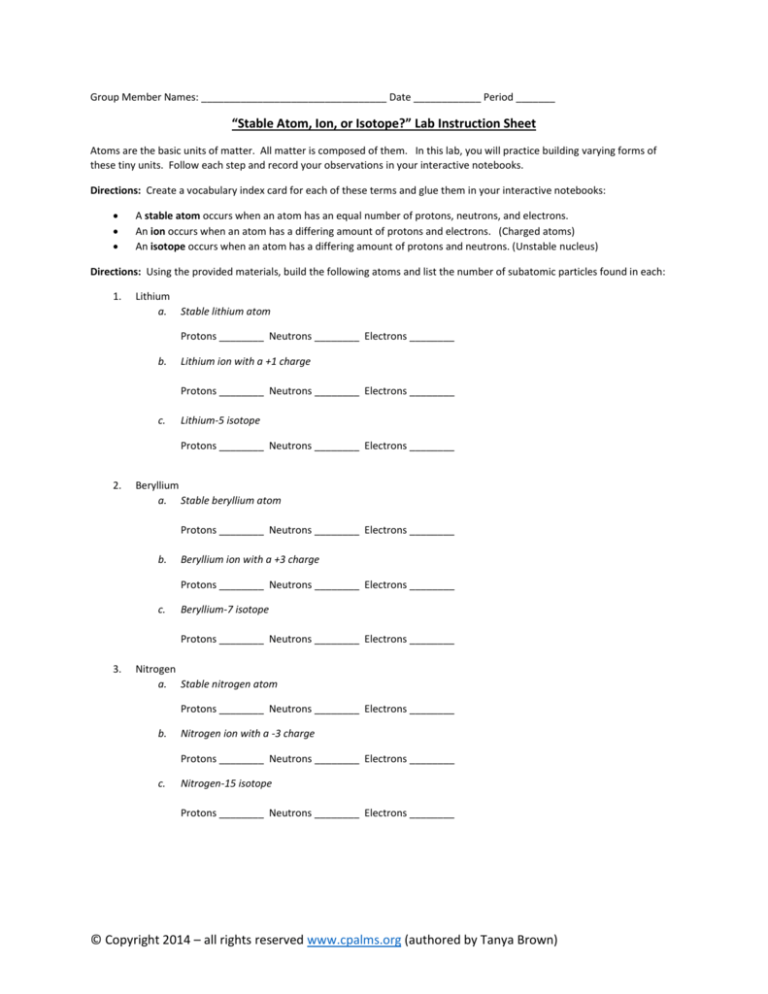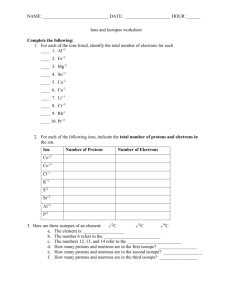
Group Member Names: _________________________________ Date ____________ Period _______
“Stable Atom, Ion, or Isotope?” Lab Instruction Sheet
Atoms are the basic units of matter. All matter is composed of them. In this lab, you will practice building varying forms of
these tiny units. Follow each step and record your observations in your interactive notebooks.
Directions: Create a vocabulary index card for each of these terms and glue them in your interactive notebooks:
A stable atom occurs when an atom has an equal number of protons, neutrons, and electrons.
An ion occurs when an atom has a differing amount of protons and electrons. (Charged atoms)
An isotope occurs when an atom has a differing amount of protons and neutrons. (Unstable nucleus)
Directions: Using the provided materials, build the following atoms and list the number of subatomic particles found in each:
1.
Lithium
a. Stable lithium atom
Protons ________ Neutrons ________ Electrons ________
b.
Lithium ion with a +1 charge
Protons ________ Neutrons ________ Electrons ________
c.
Lithium-5 isotope
Protons ________ Neutrons ________ Electrons ________
2.
Beryllium
a. Stable beryllium atom
Protons ________ Neutrons ________ Electrons ________
b.
Beryllium ion with a +3 charge
Protons ________ Neutrons ________ Electrons ________
c.
Beryllium-7 isotope
Protons ________ Neutrons ________ Electrons ________
3.
Nitrogen
a. Stable nitrogen atom
Protons ________ Neutrons ________ Electrons ________
b.
Nitrogen ion with a -3 charge
Protons ________ Neutrons ________ Electrons ________
c.
Nitrogen-15 isotope
Protons ________ Neutrons ________ Electrons ________
© Copyright 2014 – all rights reserved www.cpalms.org (authored by Tanya Brown)
Answer Key:
1. A. 3 protons, 3 neutrons, 3 electrons
B. 3 protons, 3 neutrons, 2 electrons
C. 3 protons, 2 neutrons, 3 electrons
2.
A. 4 protons, 4 neutrons, 4 electrons
B. 4 protons, 4 neutrons, 1 electron
C. 4 protons, 3 neutrons, 4 electrons
3.
A. 7 protons, 7 neutrons, 7 electrons
B. 7 protons, 7 neutrons, 10 electrons
C. 7 protons, 8 neutrons, 7 electrons
© Copyright 2014 – all rights reserved www.cpalms.org (authored by Tanya Brown)








